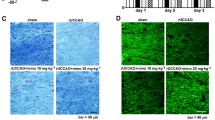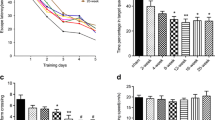Abstract
Cerebrovascular white matter lesions represent an age-related neurodegenerative condition that appears as a hyperintense signal on magnetic resonance images. These lesions are frequently observed in aging, hypertension and cerebrovascular disease, and are responsible for cognitive decline and gait disorders in the elderly population. In humans, cerebrovascular white matter lesions are accompanied by apoptosis of oligodendroglia, and have been thought to be caused by chronic cerebral ischemia. In the present study, we tested whether chronic cerebral hypoperfusion induces white matter lesions and apoptosis of oligodendroglia in the rat. Doppler flow meter analysis revealed an immediate reduction of cerebral blood flow ranging from 30% to 40% of that before operation; this remained at 52–64% between 7 and 30 days after operation. Transferrin-immunoreactive oligodendroglia decreased in number and the myelin became degenerated in the medial corpus callosum at 7 days and thereafter. Using the TUNEL method, the number of cells showing DNA fragmentation increased three- to eightfold between 3 and 30 days post-surgery compared to sham-operated animals. Double labeling with TUNEL and immunohistochemistry for markers of either astroglia or oligodendroglia showed that DNA fragmentation occurred in both of these glia. Messenger RNA for caspase-3 increased approximately twofold versus the sham-operated rats between 1 and 30 days post-surgery. Immunohistochemistry revealed up-regulation of caspase-3 in the oligodendroglia of the white matter, and also in the astroglia and neurons of the gray matter. Molecules involved in apoptotic signaling such as TNF-α and Bax were also up-regulated in glial cells. These results indicate that chronic cerebral hypoperfusion induces white matter degeneration in association with DNA fragmentation in oligodendroglia.






Similar content being viewed by others
References
Akassoglou K, Bauer J, Kassiotis G, Pasparakis M, Lassmann H, Kollias G, Probert L (1998) Oligodendrocyte apoptosis and primary demyelination induced by local TNF/p55 TNF receptor signaling in the central nervous system of transgenic mice: models for multiple sclerosis with primary oligodendrogliopathy. Am J Pathol 153:801–813
Akiguchi I, Tomimoto H, Suenaga T, Wakita H, Budka H (1997) Alterations of glia and axons in the brains of Binswanger's disease patients. Stroke 28:1423–1429
Bennett SA, Tenniswood M, Chen JH, Davidson CM, Keyes MT, Fortin T, Pappas BA (1998) Chronic cerebral hypoperfusion elicits neuronal apoptosis and behavioral impairment. NeuroReport 9:161–166
Boone KB, Miller BL, Lesser IM, Mehringer CM, Hill-Gutierrez E, Goldberg MA, Berman NG (1992) Neuropsychological correlates of white-matter lesions in healthy elderly subjects. A threshold effect. Arch Neurol 49:549–554
Brown WR, Moody DM, Thore CR, Challa VR (2000) Apoptosis in leukoaraiosis. Am J Neuroradiol 21:79–82
Casaccia-Bonnefil P (2000) Cell death in the oligodendrocyte lineage: a molecular perspective of life/death decisions in development and disease. Glia 29:124–135
D'Souza SD, Alinauskas K, McCrea E, Goodyer C, Antel JP (1995) Differential susceptibility of human CNS-derived cell populations to TNF-dependent and independent immune-mediated injury. J Neurosci 15:7293–7300
D'Souza SD, Alinauskas KA, Antel JP (1996) Ciliary neurotrophic factor selectively protects human oligodendrocytes from tumor necrosis factor-mediated injury. J Neurosci Res 43:289–298
Eizenberg O, Faber-Elman A, Gottlieb E, Oren M, Rotter V, Schwartz M (1995) Direct involvement of p53 in programmed cell death of oligodendrocytes. EMBO J 14:1136–1144
Furuta A, Ishii N, Nishihara Y, Horie A (1991) Medullary arteries in aging and dementia. Stroke 22:442–446
Harmon BV, Corder AM, Collins RJ, Gobe GC, Allen J, Allan DJ, Kerr JF (1990) Cell death induced in a murine mastocytoma by 42–47 degrees C heating in vitro: evidence that the form of death changes from apoptosis to necrosis above a critical heat load. Int J Radiat Biol 58:845–858
Hisahara S, Shoji S, Okano H, Miura M (1997) ICE/ced-3 family executes oligodendrocyte apoptosis by tumor necrosis factor. J Neurochem 69:10–20
Ihara M, Tomimoto H, Kinoshita M, Junseo O, Noda M, Wakita H, Akiguchi I, Shibasaki H (2001) Chronic cerebral hypoperfusion induces MMP-2 but not MMP-9 expression in the microglia and vascular endothelium of the white matter. J Cereb Blood Flow Metab 21:828–834
Laszkiewicz I, Mouzannar R, Wiggins RC, Konat GW (1998) Delayed oligodendrocyte degeneration induced by brief exposure to hydrogen peroxide. Curr Opin Neurol 11:293–298
Li GL, Farooque M, Holtz A, Olsson Y (1999) Apoptosis of oligodendrocytes occurs for long distances away from the primary injury after compression trauma to rat spinal cord. Acta Neuropathol (Berl) 98:473–480
Li Y, Sharov VG, Jiang N, Zaloga C, Sabbah HN, Chopp M (1995) Ultrastructural and light microscopic evidence of apoptosis after middle cerebral artery occlusion in the rat. Am J Pathol 146:1045–1051
Lin J-Xi, Tomimoto H, Akiguchi I, Matsuo M, Wakita H, Shibasaki H, Budka H (2000) Vascular cell components of the medullary arteries in Binswanger's disease brains; a morphometric and immunoelectron microscopic study. Stroke 31:1838–1842
Mabuchi T, Kitagawa K, Ohtsuki T, Kuwabara K, Yagita Y, Yanagihara T, Hori M, Matsumoto M (2000) Contribution of microglia/macrophages to expansion of infarction and response of oligodendrocytes after focal cerebral ischemia in rats. Stroke 31:1735–1743
Masumura M, Hata R, Nagai Y, Sawada T (2001) Oligodendroglial cell death with DNA fragmentation in the white matter under chronic cerebral hypoperfusion: comparison between normotensive and spontaneously hypertensive rats. Neurosci Res 39:401–412
Merrill JE, Ignarro LJ, Sherman MP, Melinek J, Lane TE (1993) Microglial cell cytotoxicity of oligodendrocytes is mediated through nitric oxide. J Immunol 151:2132–2141
Miura M, Friedlander RM, Yuan J (1995) Tumor necrosis factor-induced apoptosis is mediated by a CrmA-sensitive cell death pathway. Proc Natl Acad Sci USA 92:8318–8322
Ni B, Wu X, Su Y, Stephenson D, Smalstig EB, Clemens J, Paul SM (1998) Transient global forebrain ischemia induces a prolonged expression of the caspase-3 mRNA in rat hippocampal CA1 pyramidal neurons. J Cereb Blood Flow Metab 18:248–256
Ni JW, Matsumoto K, Li HB, Murakami Y, Watanabe H (1995) Neuronal damage and decrease of central acetylcholine level following permanent occlusion of bilateral common carotid arteries in rat. Brain Res 673:290–296
Otori T, Katsumata T, Kashiwagi F, Katayama Y, Terashi A (1996) Measurement of regional cerebral blood flow (rCBF) and glucose utilization (rCGU) in rat brain under chronic hypoperfusion following bilateral carotid occlusion. Cerebrovasc Dis [Suppl] 6:71
Pantoni L, Garcia JH, Gutierrez JA (1996) Cerebral white matter is highly vulnerable to ischemia. Stroke 27:1641–1646
Petito CK, Olarte JP, Roberts B, Nowak TS Jr, Pulsinelli WA (1998) Selective glial vulnerability following transient global ischemia in rat brain. J Neuropathol Exp Neurol 57:231–238
Probert L, Akassoglou K, Pasparakis M, Kontogeorgos G, Kollias G (1995) Spontaneous inflammatory demyelinating disease in transgenic mice showing central nervous system-specific expression of tumor necrosis factor alpha. Proc Natl Acad Sci USA 92:11294–11298
Schmidt R, Fazekas F, Offenbacher H, Dusek T, Zach E, Reinhart B, Grieshofer P, Freidl W, Eber B, Schumacher M, Koch M, Lechner H (1993) Neuropsychologic correlates of MRI white matter hyperintensities: a study of 150 normal volunteers. Neurology 43:2490–2494
Selmaj K, Raine CS (1988) Tumor necrosis factor mediates myelin damage in organotypic cultures of nervous tissue. Ann NY Acad Sci 540:568–570
Soliven B, Szuchet S (1995) Signal transduction pathways in oligodendrocytes: role of tumor necrosis factor-α. Int J Dev Neurosci 13:351–367
Springer JE, Azbill RD, Knapp PE (1999) Activation of the caspase-3 apoptotic cascade in traumatic spinal cord injury. Nat Med 5:943–946
Sullivan MO, Lythgoe DJ, Pereira AC, Summers PE, Jarosz JM, Williams SCR, Markus HS (2002) Patterns of cerebral blood flow reduction in patients with ischemic leukoaraiosis. Neurology 59:321–326
Tanaka K, Ogawa N, Asanuma M, Kondo Y, Nomura M (1996) Relationship between cholinergic dysfunction and discrimination learning disabilities in Wistar rats following chronic cerebral hypoperfusion. Brain Res 729:55–65
Tomimoto H, Akiguchi I, Akiyama H, Kimura J, Yanagihara T (1993) T cell infiltration and expression of MHC class II antigen by macrophage/microglia in a heterogeneous group of leukoencephalopathy. Am J Pathol 143:579–586
Tomimoto H, Akiguchi I, Suenaga T, Nishimura M, Wakita H, Nakamura S, Kimura J (1996) Alterations of the blood-brain barrier and glial cells in white matter lesions in cerebrovascular and Alzheimer's disease patients. Stroke 27:2069–2074
Tomimoto H, Akiguchi I, Suenaga T, Nishimura M, Wakita H, Nakamura S, Kimura J (1997) Regressive change of astroglia in white matter lesions in cerebrovascular and Alzheimer's disease patients. Acta Neuropathol 94:146–152
Tomimoto H, Ihara M, Wakita H, Lin J-Xi, Akiguchi I, Shibasaki H, Kinoshita M (2001) Caspase mediated apoptosis of oligodendroglia in leukoaraiosis. Abstracts of the 1st International Workshop of the White Matter Study Group. p 25
Tsuchiya M, Sako K, Yura S, Yonemasu Y (1992) Cerebral blood flow and histopathological changes following permanent bilateral carotid artery ligation in Wistar rats. Exp Brain Res 89:87–92
Uberti D, Yavin E, Gil S, Ayasola KR, Goldfinger N, Rotter V (1999) Hydrogen peroxide induces nuclear translocation of p53 and apoptosis in cells of oligodendroglia origin. Brain Res Mol Brain Res 65:167–175
Wakita H, Tomimoto H, Akiguchi I, Kimura J (1994) Glial activation and white matter changes in the rat brain induced by chronic cerebral hypoperfusion: an immunohistochemical study. Acta Neuropathol 87:484–492
Wakita H, Tomimoto H, Akiguchi I, Kimura J (1995) Protective effect of cyclosporin A on the white matter changes in the rat after chronic cerebral hypoperfusion. Stroke 26:1415–1422
Yamanouchi H (1991) Loss of white matter oligodendrocytes and astrocytes in progressive subcortical vascular encephalopathy of Binswanger type. Acta Neurol Scand 83:301–305
Acknowledgements
This work was supported by grants from the Ministry of Education, Culture, Sports, Science and Technology, Japan. This work was supported by a Grant-in-Aid for Scientific Research on Priority Areas from the Japanese Ministry of Education, Science and Culture (H.T). We are indebted to Miss. Hitomi Nakabayashi for excellent technical assistance.
Author information
Authors and Affiliations
Corresponding author
Rights and permissions
About this article
Cite this article
Tomimoto, H., Ihara, M., Wakita, H. et al. Chronic cerebral hypoperfusion induces white matter lesions and loss of oligodendroglia with DNA fragmentation in the rat. Acta Neuropathol 106, 527–534 (2003). https://doi.org/10.1007/s00401-003-0749-3
Received:
Revised:
Accepted:
Published:
Issue Date:
DOI: https://doi.org/10.1007/s00401-003-0749-3




